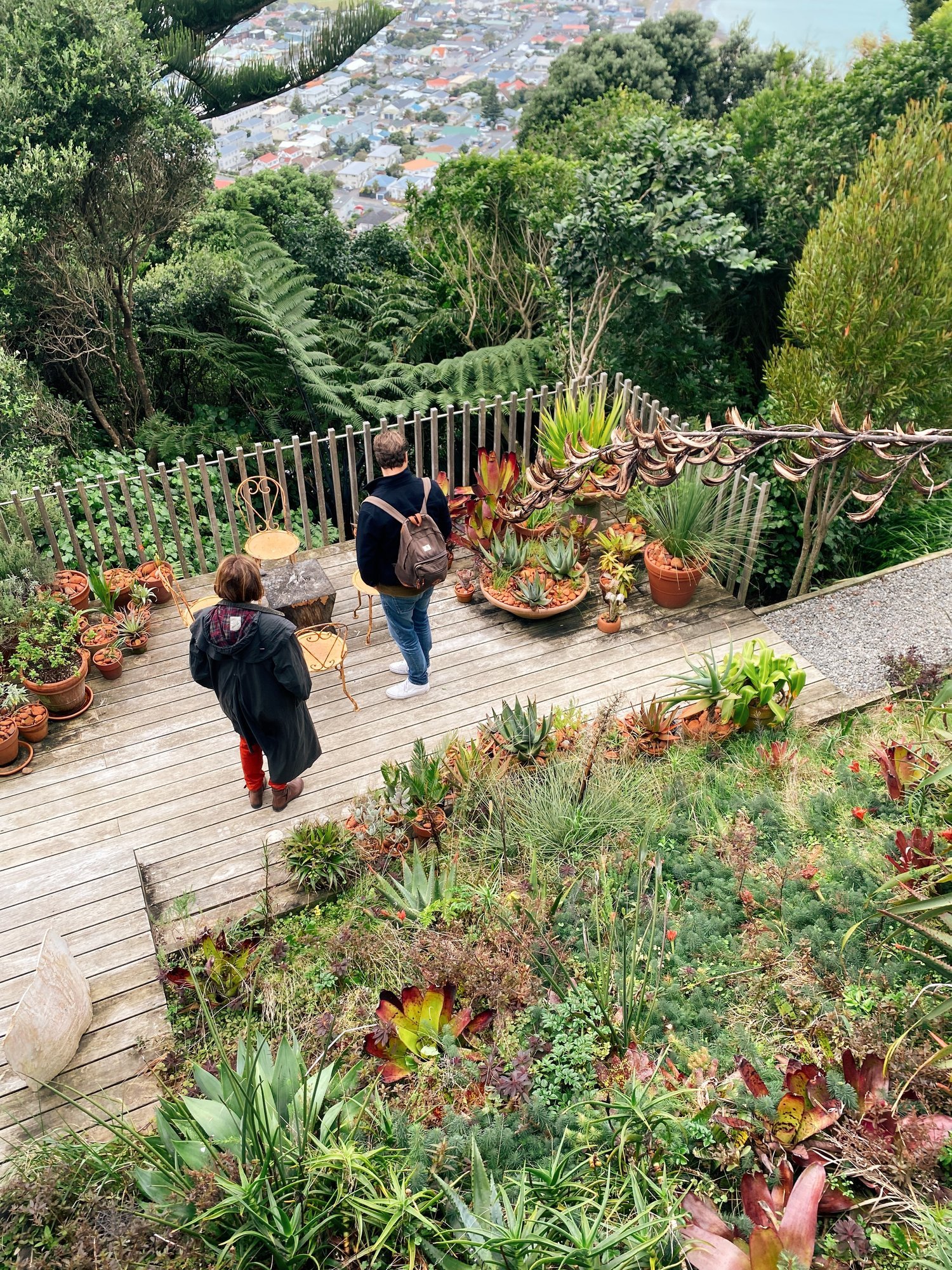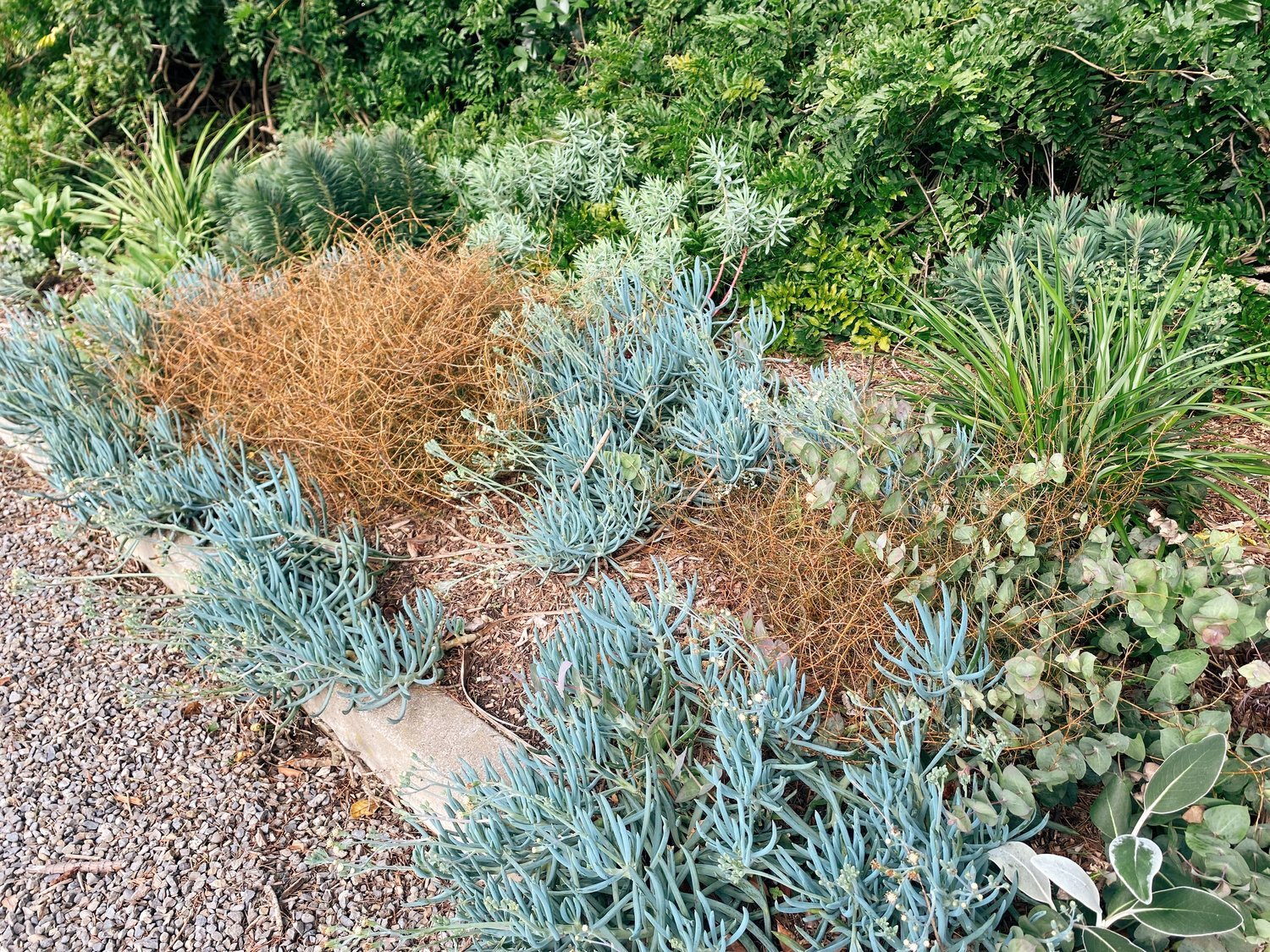NZ GARDENS TRUST CONFERENCE 2023
In early April I braved a bucking southerly to touch down in Wellington and, for the second time, join the New Zealand Gardens Trust Conference.
After skipping a year due to Covid, 80 attendees were fizzing with enthusiasm for not only the lineup of garden visits and seminars but the deliciously satisfying opportunity to turn to anyone and talk plants with equal enthusiasm.
The crowd from around the country, as always, was diverse in age and horticultural focus ranging from young teams from botanic gardens, landscape designers, owners of member gardens and the gang like me – enthusiastic people that join the event to learn as Friends of the Trust.
Read on for my takeaways that centred around resilient planting and creative use of New Zealand natives.
Words and photography by Julia Atkinson-Dunn
Ross Palmer’s extraordinary garden on a step slope in southern Wellington.
Ross Palmer’s house perched amid the resilient habitat he has created.
Over three and a half days we roamed the city and Wairarapa region touring public spaces like the beautiful Wellington Botanic Gardens and Ōtari-Wilton’s Bush with an incredible behind-the-scenes tour of Government House and its grounds. We ventured through the Hutt Valley and over the Rimutakas to visit extraordinary gardens that presented starkly different avenues of values, aesthetic, size and stages of development. On Wellington’s south coast, we experienced what it is to garden on a steep exposed slope and the magic found in creating ecosystems with a hardy and unexpected mix of native and exotic plants.
The conference goer’s gathering for the guided talk through Rototowai and learning about its redevelopment and new direction.
At every turn, each gardener’s ideas were challenged by someone else’s lens on planting – this was incredibly invigorating and inspiring. Notes were swapped on experience from differing climates and we were given an insight into the box blight epidemic that is sweeping through the Wellington region!
By the night of the conference dinner and designer Andy Hamilton’s brilliant overview of his recent projects, I had flip-flopped on my planned garden changes at the front of my house no less than ten times. Creativity permeated every moment of this trip.
I had some particular highlights and resulting discoveries that I thought might be interesting to share with you:
Ross Palmer and the enormous Holm Oak he uncovered in the undergrowth at Rototawai. It features unusual spiral bands that it has naturally developed to support its weight.
Climate resilient planting and a special Holm oak.
The expansive homestead and 5-hectare grounds of Rototawai near Featherston have in recent years returned to the Bidwell family and, under the direction of landscape designer Ross Palmer, was experiencing a truly energising revival of its historic planting and swathes of bare space.
With a shift toward the future and away from traditional approaches that would have been used at the time of its establishment, Ross has established beds of exciting and resilient plants with very low water needs. We were all intrigued by his curation and I, in particular, look forward to the juxtaposition of these informal beds against the historical plaster homestead. This will be a fascinating place to visit in the years to come!
During his tour, Ross led us into the band of thick sheltering trees where he had uncovered some ancient gems. The highlight of these for me was an enormous Holm oak (Quercus ilex) which is an unusually evergreen member of the oak family, originally from the Mediterranean. However, what was most unusual about this specimen was one giant limb that had grown at a wide angle away from the main trunk and in doing so, worked out its own way to support this weight against the high winds of the region.
The limb had large ridged bands that spiralled anti-clockwise around its length, an interesting self-generated phenomenon produced to strengthen itself. These spiral fibres can bend and twist without breaking under pressure, and it was a treat to see such a visible and largescale example of this in person.
Ross Palmer’s fascinating an beautiful new resilient, drought tolerant planting at Rototawai.
A fresh look at natives
In my own experience, most native planting I had viewed within garden spaces tended toward the recreation of bush. While this is of course beautiful in itself, in my small space I hadn’t ever felt motivated to try to integrate it, feeling that I couldn’t quite get native plants to be friends with my exotic ones. I can safely say any ignorant preconceptions I had about the use of natives in a garden were well and truly blown out of the water on this trip.
While visiting the intimate spaces of the 20-year-old Gillies Garden hidden high in the hills of Upper Hutt I was struck by the meeting of the surrounding mature bush with the traditional elements of topiary and exotic plants. I realised for the first time that this distinctly showcased a uniquely New Zealand-type of garden that couldn’t be compared to others around the world. Peter and Nellie Gillies had tenderly gardened with, and at the edges of, the bush, creating a sanctuary where design met the neighbouring wildness and ecosystem, leaving an entirely whimsical feeling.
Traditional elements of topiary meet the mature surrounding bush at the Gillies Garden in Upper Hutt. This garden garden can be visited - view on the New Zealand Gardens Trust site.
The Gilies garden also revealed the fun and creativity to be had in compact spaces.
Beyond this, the planting undertaken at Government House in Wellington, transformed and managed by Bark, led by Kerei Thompson really lit a fire under me. After many different phases in its development since 1910, for over 20 years the Bark team have cleverly transformed the planting to find a balance of finesse and formality with a high emphasis on New Zealand natives. Large mounding borders of native shrubs were ignited by the considered inclusion of seasonal interest including examples of hydrangeas, phlomis and miscanthus. Here exotics played second fiddle to the native planting which was showcased in natural groupings as well as clipped and pruned to create incredible formal notes. It all rightfully had a sense of occasion and I am sure any visiting foreign dignitary with an interest in gardening would be captured by the range and curation of what is offered.
Exotic planting igniting large beds of beautiful New Zealand natives at Wellington’s Government House.
This is an expanded version of the article featured in my Stuff ‘Homed’ gardening column for beginners , The Press, Dominion Post and other regional papers on April 13th 2023
All words and images are my own.











